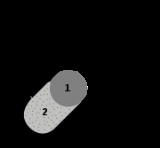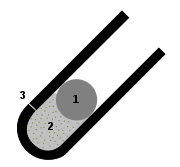
Touch hole
Encyclopedia

Cannon
A cannon is any piece of artillery that uses gunpowder or other usually explosive-based propellents to launch a projectile. Cannon vary in caliber, range, mobility, rate of fire, angle of fire, and firepower; different forms of cannon combine and balance these attributes in varying degrees,...
or muzzleloading gun is ignited. In small arms
Small arms
Small arms is a term of art used by armed forces to denote infantry weapons an individual soldier may carry. The description is usually limited to revolvers, pistols, submachine guns, carbines, assault rifles, battle rifles, multiple barrel firearms, sniper rifles, squad automatic weapons, light...
, the flash from a charge of priming
Priming
Priming may refer to:* Priming , a process in which the processing of a target stimulus is aided or altered by the presentation of a previously presented stimulus....
held in the flash pan
Flash pan
The flash pan or priming pan is a small receptacle for priming powder, found next to the touch hole on muzzleloading guns. Flash pans are found on gonnes, matchlocks, wheellocks, snaplocks, snaphances, and flintlocks....
is enough to ignite the charge within. In artillery
Artillery
Originally applied to any group of infantry primarily armed with projectile weapons, artillery has over time become limited in meaning to refer only to those engines of war that operate by projection of munitions far beyond the range of effect of personal weapons...
, priming powder, a fuse
Fuse (explosives)
In an explosive, pyrotechnic device or military munition, a fuse is the part of the device that initiates function. In common usage, the word fuse is used indiscriminately...
, squib
Squib (explosive)
A squib is a miniature explosive device used in a wide range of industries, from special effects to military applications. It resembles a tiny stick of dynamite, both in appearance and construction, although with considerably less explosive power...
, or friction igniter is inserted into the touch hole to ensure ignition of the charge.
The powder in the touch hole was lit either with a slow match
Slow match
Slow match or match cord is the very slow burning cord or twine fuse used by early gunpowder musketeers, artillerymen, and soldiers to ignite matchlock muskets, cannons, and petards...
or a linstock
Linstock
A linstock is a staff with a fork at one end to hold a lighted slow match. The name was adapted from the Dutch lontstok, "match stick"...
.
Spiking the guns
If a cannonCannon
A cannon is any piece of artillery that uses gunpowder or other usually explosive-based propellents to launch a projectile. Cannon vary in caliber, range, mobility, rate of fire, angle of fire, and firepower; different forms of cannon combine and balance these attributes in varying degrees,...
was in danger of being captured by the enemy, its crew would "spike" the gun to prevent it from being used against them. This would involve hammering a barbed steel spike into the touch-hole, which could only be removed with very great difficulty. Spiking an enemy's guns could also be done to prevent counterattacks and protect ships during withdrawal, as in the case of the Ranger's attack on Whitehaven during the American Revolutionary War.

